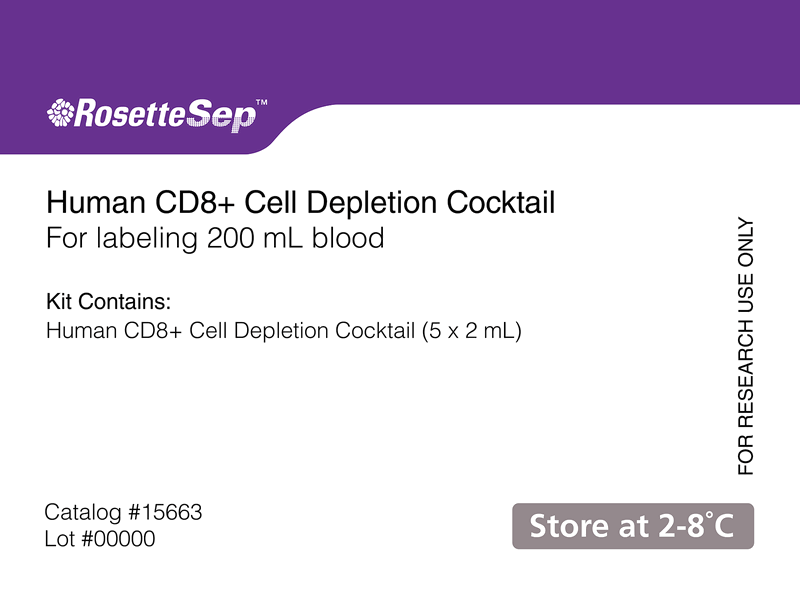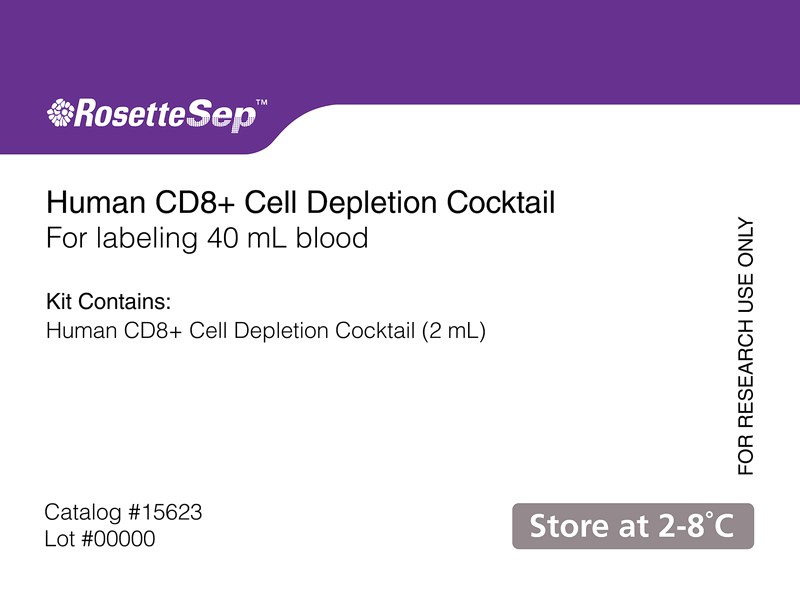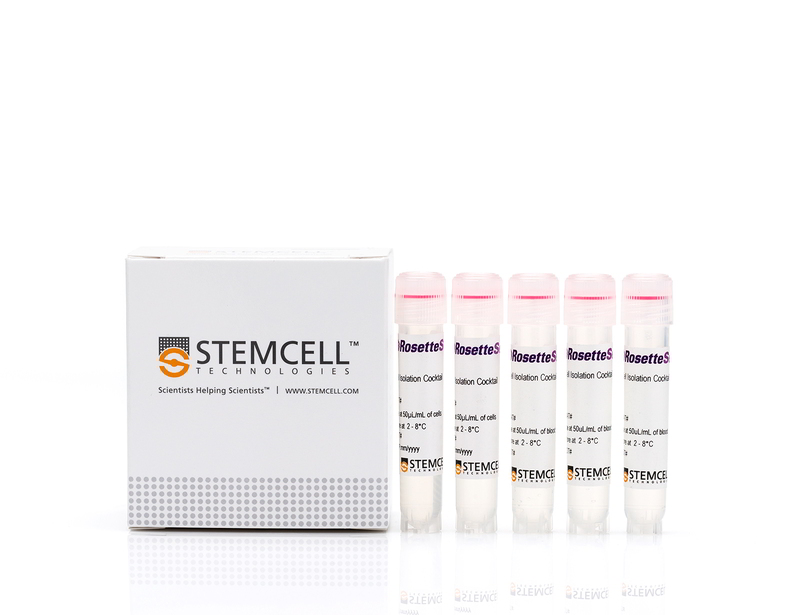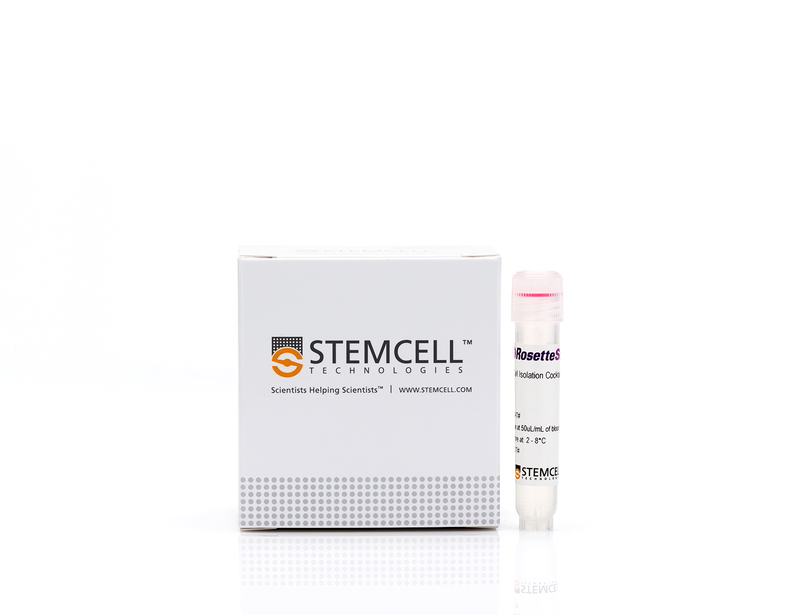RosetteSep™ Human CD8 Depletion Cocktail
Immunodensity depletion cocktail
概要
The RosetteSep™ Human CD8 Depletion Cocktail is designed to deplete CD8+ cells from whole blood. Unwanted cells are targeted for removal with Tetrameric Antibody Complexes recognizing CD8 and glycophorin A on red blood cells (RBCs). When centrifuged over a buoyant density medium such as Lymphoprep™ (Catalog #07801), the unwanted cells pellet along with the RBCs. The CD8+ depleted fraction is present as a highly enriched population at the interface between the plasma and the buoyant density medium.
Advantages
• Fast and easy-to-use
• Requires no special equipment or training
• Untouched, viable cells
• Can be combined with SepMate™ for consistent, high-throughput sample processing
• Requires no special equipment or training
• Untouched, viable cells
• Can be combined with SepMate™ for consistent, high-throughput sample processing
Components
- RosetteSep™ Human CD8 Depletion Cocktail (Catalog #15623)
- RosetteSep™ Human CD8 Depletion Cocktail, 2 mL
- RosetteSep™ Human CD8 Depletion Cocktail (Catalog #15663)
- RosetteSep™ Human CD8 Depletion Cocktail, 5 x 2 mL
Subtype
Cell Isolation Kits
Cell Type
T Cells, T Cells, CD8+
Species
Human
Sample Source
Buffy Coat, Whole Blood
Selection Method
Depletion
Application
Cell Isolation
Brand
RosetteSep
Area of Interest
Immunology
技术资料
| Document Type | 产品名称 | Catalog # | Lot # | 语言 |
|---|---|---|---|---|
| Product Information Sheet | RosetteSep™ Human CD8 Depletion Cocktail | 15623, 15663 | All | English |
| Safety Data Sheet | RosetteSep™ Human CD8 Depletion Cocktail | 15623 | All | English |
数据及文献
Data
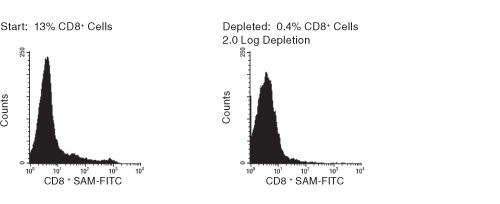
Figure 1. FACS Histogram Results Using RosetteSep™ Human CD8+ Cell Depletion Cocktail
Publications (5)
Virology 2020 may
Comparison of the antiviral activity of the microbicide candidate griffithsin and its tandemers derivatives against different modes of HIV-1 transmission.
Abstract
Abstract
Tandemers 2MG, 2MG3, 3MG and 4MG are derivatives of the potent anti-HIV-1 microbicide candidate griffithsin (GRFT). We compared these compounds anti-HIV-1 activity to GRFT using the viruses CAP206.08 and CAAN5342.A2 that have decreased sensitivity to this lectin. The 2MG and 2MG3 tandemers had similar activity to GRFT against cell-free and cell-associated viruses, while 3MG and 4MG were significantly more potent. Furthermore, the restoration of the 234N or 295N glycan in these viruses, known to increase sensitivity to GRFT, also increased sensitivity to 2MG and 2MG3, and not to 3MG and 4MG. In addition, GRFT resistant viruses generated in-vitro were equally resistant to 2MG and 2MG3 while they had considerably low resistance to 3MG and 4MG. Lastly, all five compounds showed increased inhibitory activity in seminal and vaginal simulants although the effect was more pronounced in the former. These data support further studies of tandemers as potential microbicides.
Journal of medicinal chemistry 2019 dec
Enzymatic Preparation of 2'-5',3'-5'-Cyclic Dinucleotides, Their Binding Properties to Stimulator of Interferon Genes Adaptor Protein, and Structure/Activity Correlations.
Abstract
Abstract
Cyclic dinucleotides are second messengers in the cyclic GMP-AMP synthase (cGAS)-stimulator of interferon genes (STING) pathway, which plays an important role in recognizing tumor cells and viral or bacterial infections. They bind to the STING adaptor protein and trigger expression of cytokines via TANK binding kinase 1 (TBK1)/interferon regulatory factor 3 (IRF3) and inhibitor of nuclear factor-$\kappa$B (I$\kappa$B) kinase (IKK)/nuclear factor-$\kappa$B (NF$\kappa$B) signaling cascades. In this work, we describe an enzymatic preparation of 2'-5',3'-5'-cyclic dinucleotides (2'3'CDNs) with use of cyclic GMP-AMP synthases (cGAS) from human, mouse, and chicken. We profile substrate specificity of these enzymes by employing a small library of nucleotide-5'-triphosphate (NTP) analogues and use them to prepare 33 2'3'CDNs. We also determine affinity of these CDNs to five different STING haplotypes in cell-based and biochemical assays and describe properties needed for their optimal activity toward all STING haplotypes. Next, we study their effect on cytokine and chemokine induction by human peripheral blood mononuclear cells (PBMCs) and evaluate their cytotoxic effect on monocytes. Additionally, we report X-ray crystal structures of two new CDNs bound to STING protein and discuss structure-activity relationship by using quantum and molecular mechanical (QM/MM) computational modeling.
Nature communications 2018 SEP
Differential processing of HIV envelope glycans on the virus and soluble recombinant trimer.
Abstract
Abstract
As the sole target of broadly neutralizing antibodies (bnAbs) to HIV, the envelope glycoprotein (Env) trimer is the focus of vaccination strategies designed to elicit protective bnAbs in humans. Because HIV Env is densely glycosylated with 75-90 N-glycans per trimer, most bnAbs use or accommodate them in their binding epitope, making the glycosylation of recombinant Env a key aspect of HIV vaccine design. Upon analysis of three HIV strains, we here find that site-specific glycosylation of Env from infectious virus closely matches Envs from corresponding recombinant membrane-bound trimers. However, viral Envs differ significantly from recombinant soluble, cleaved (SOSIP) Env trimers, strongly impacting antigenicity. These results provide a benchmark for virus Env glycosylation needed for the design of soluble Env trimers as part of an overall HIV vaccine strategy.
Journal of virology 2007 AUG
In vivo and in vitro escape from neutralizing antibodies 2G12, 2F5, and 4E10.
Abstract
Abstract
Recently, passive immunization of human immunodeficiency virus (HIV)-infected individuals with monoclonal antibodies (MAbs) 2G12, 2F5, and 4E10 provided evidence of the in vivo activity of 2G12 but raised concerns about the function of the two membrane-proximal external region (MPER)-specific MAbs (A. Trkola, H. Kuster, P. Rusert, B. Joos, M. Fischer, C. Leemann, A. Manrique, M. Huber, M. Rehr, A. Oxenius, R. Weber, G. Stiegler, B. Vcelar, H. Katinger, L. Aceto, and H. F. Gunthard, Nat. Med. 11:615-622, 2005). In the light of MPER-targeting vaccines under development, we performed an in-depth analysis of the emergence of mutations conferring resistance to these three MAbs to further elucidate their activity. Clonal analysis of the MPER of plasma virus samples derived during antibody treatment confirmed that no changes in this region had occurred in vivo. Sequence analysis of the 2G12 epitope relevant N-glycosylation sites of viruses derived from 13 patients during the trial supported the phenotypic evaluation, demonstrating that mutations in these sites are associated with resistance. In vitro selection experiments with isolates of four of these individuals corroborated the in vivo finding that virus strains rapidly escape 2G12 pressure. Notably, in vitro resistance mutations differed, in most cases, from those found in vivo. Importantly, in vitro selection with 2F5 and 4E10 demonstrated that resistance to these MAbs can be difficult to achieve and can lead to selection of variants with impaired infectivity. This remarkable vulnerability of the virus to interference within the MPER calls for a further evaluation of the safety and efficacy of MPER-targeting therapeutic and vaccination strategies.
Journal of immunology (Baltimore, Md. : 1950) 2003 DEC
Reconstitution of virus-specific CD4 proliferative responses in pediatric HIV-1 infection.
Abstract
Abstract
Gag-specific CD4 proliferative responses correlate inversely with HIV-1 RNA levels in infected adults, and robust responses are characteristic of long-term nonprogressive infection. However, strong responses are seldom detected in adult subjects with progressive infection and are not generally reconstituted on highly active antiretroviral therapy (HAART). To date, the role of HIV-1-specific Th responses in children has not been thoroughly examined. We characterized Gag-specific CD4 responses among 35 perinatally infected subjects, including 2 children who spontaneously control viremia without antiretroviral therapy, 21 children with viral loads (VL) of textless400 on HAART, and 12 viremic children. Gag-specific Th activity was assessed by lymphoproliferative assay, and responses were mapped using overlapping Gag peptides in an IFN-gamma ELISPOT. Robust proliferative responses were detected in the children exhibiting spontaneous control of viremia, and mapping of targeted Gag regions in one such subject identified multiple epitopes. Among children textgreateror=5 years old, 14 of 17 subjects with VL of textless400 on HAART demonstrated a significant p24 proliferative response (median p24 stimulation index, 20), in contrast with only 1 of 9 viremic children (median p24 stimulation index, 2.0; p = 0.0008). However, no subject younger than 5 years of age possessed a significant response, even when viremia was fully suppressed. When compared with adults with VL of textless400 on HAART, Th responses among children with VL of textless400 were both more frequent (p = 0.009) and of greater magnitude (p = 0.002). These data suggest that children may have a greater intrinsic capacity to reconstitute HIV-1-specific immunity than adults, and may be excellent candidates for immune-based therapies.

